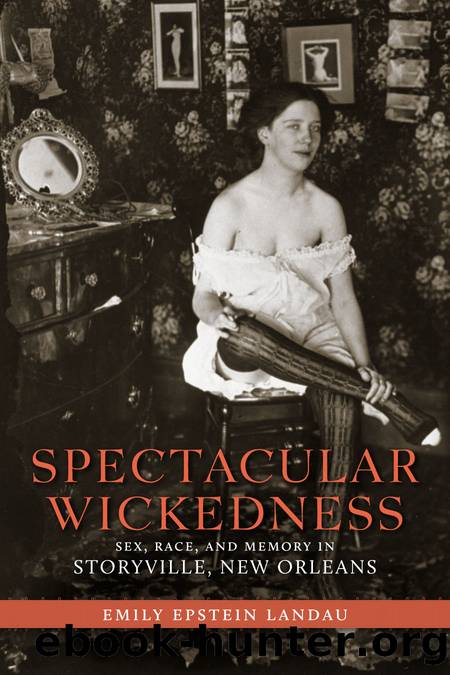Spectacular Wickedness by Emily Epstein Landau

Author:Emily Epstein Landau
Language: eng
Format: epub
Publisher: LSU Press
Published: 2013-02-15T00:00:00+00:00
CHAPTER SIX
The Last Stronghold of the Old Regime
It is well known that New Orleans is the Sodom of the South.
âLetter to Raymond Fosdick, chairman of the Commission on Training Camp Activities
Enforcing Boundaries within Storyville: Race and Reform
We have seen how most business leaders and councilmen wanted to confine vice to discrete (and discreet) locations; they desired to clear the streets for respectable persons and legitimate business concerns. As in all cities, however, some reformers continued to seek to eliminate the red-light district itself and put an end to prostitution. In New Orleans, such efforts often focused on interracial sex, race mixing, and âdisorderly negroesâ within the boundaries of Storyville. As early as the 1850s, Nativist politicians had linked their message of economic reform to a strong stance against illicit sex, particularly prostitution and interracial sex, in effect conflating vice, economic woe, non-white âothersâ (blacks and immigrants), and sex across the color line in their efforts to stem municipal corruption. In the 1890s and 1910s, reformers focused on race mixing and the perceived bad behavior of black people in Storyville to catalyze the reform of the red-light district. While they were unsuccessful, we may see in their efforts an elaboration of white supremacist ideology: they associated immorality with unruly people of color and sex across the color lineâeven within the red-light districtâand so inscribed race in âreform.â
In Storyville, at first, the dance halls received more attention even than the brothels or cribs. As in the efforts to segregate vice before the opening of Storyville, prostitution per se was almost never questioned as a moral problem. After legislation brought Storyville into being, prostitution was still accepted as a fact of life in New Orleans; now it was the disorderliness of establishments in Storyville, ones that did not even purport to sell sex, that drew the ire of the moral reformers. Early objections to the district focused on the clubs in the district, located in an area that one newspaper called âthe Mecca of bad Negroesâ toward Robertson Street, the ârearâ of the district (if Basin Street was the âfrontâ), where several dance halls catered to a black clientele. Some of these clubs predated the ordinance, contributing to the neighborhoodâs mixed character. Many people were afraid to go to the rear of the district, as âbloody fights in the area were commonplace.â And the three barrelhouses at Franklin and Customhouse were âscenes of drunkenness, vice, and disturbance at all hours of the day and night.â1 Reformers drew attention to this corner, claiming it was the meeting place for the âlowest class of cocaine fiends, petty thieves, and the general worthless blacks who work only enough to keep alive when âGraftsâ in their particular fields cannot be worked.â In fact, âthe orgies and dances in these saloons were so indecent,â according to the Item, that the chief of police was forced to denounce them publicly.
Excluding the creation of the âuptownâ or âblackâ Storyville, Chief of Police John Journée made the first of several attempts to separate white from black vice in 1902.
Download
This site does not store any files on its server. We only index and link to content provided by other sites. Please contact the content providers to delete copyright contents if any and email us, we'll remove relevant links or contents immediately.
| African Americans | Civil War |
| Colonial Period | Immigrants |
| Revolution & Founding | State & Local |
Cat's cradle by Kurt Vonnegut(13893)
Pimp by Iceberg Slim(12943)
Underground: A Human History of the Worlds Beneath Our Feet by Will Hunt(11264)
4 3 2 1: A Novel by Paul Auster(11073)
The Radium Girls by Kate Moore(10915)
American History Stories, Volume III (Yesterday's Classics) by Pratt Mara L(4828)
Perfect Rhythm by Jae(4628)
Wiseguy by Nicholas Pileggi(4598)
The Fire Next Time by James Baldwin(4350)
Paper Towns by Green John(4175)
A Higher Loyalty: Truth, Lies, and Leadership by James Comey(4038)
Pale Blue Dot by Carl Sagan(4015)
The Mayflower and the Pilgrims' New World by Nathaniel Philbrick(3918)
The Doomsday Machine by Daniel Ellsberg(3736)
Too Much and Not the Mood by Durga Chew-Bose(3698)
Killers of the Flower Moon: The Osage Murders and the Birth of the FBI by David Grann(3622)
The Borden Murders by Sarah Miller(3593)
The Sympathizer by Viet Thanh Nguyen(3513)
Killing England by Bill O'Reilly(3460)
